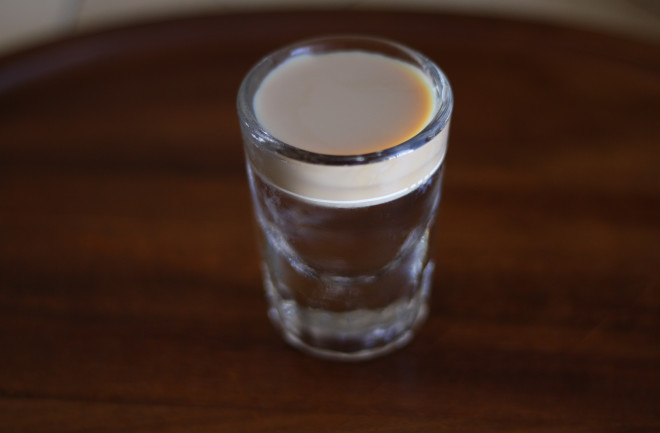[Photo Credit: Vince C Reyes]You may think a buttery nipple is just a fun shot to buy a friend on his or her birthday, but it’s more complex than that. It’s got layers… specifically two. For those not familiar with the bar classic, the buttery nipple is composed of a layer of Irish cream sitting on top of butterscotch schnapps. Buttery Nipple Shot Recipe ½ oz. Irish cream 1 oz. Butterscotch schnapps
Pour 1 oz. of Butterscotch schnapps into a chilled shot glass.
Carefully pour ½ oz. of Irish cream onto the back of a downturned spoon so it rolls from the spoon and floats on the surface of the schnapps.
Enjoy!
This and other layered shots like the American flag, the B-52, and the Alien Brain Hemorrhage, take advantage of the slight differences in density among spirits. As density, a substance’s mass per unit volume (Density = mass / volume), dictates the layering in these drinks; the most dense liquid is placed at the bottom followed by progressively less dense liquids. In the case of the buttery nipple, the less dense Irish cream floats on the more dense butterscotch schnapps. If you were to reverse the order with the butterscotch schnapps poured on the Irish cream, the layers would not form. The more dense butterscotch schnapps would sink to the bottom of the glass and result in a mixture of the two spirits. For the home bartender looking to make new layered drinks, the absolute density of a spirit is not always easy to measure. However, a different quantity, specific gravity, is often available online^1. Specific gravity is the ratio of the density of substance to water (specific gravity = density of a substance / density of water). Water has a specific gravity of 1.0. More dense liquids have specific gravities greater than 1.0 and less dense liquids have specific gravities less than 1.0. In the case of the buttery nipple shot, butterscotch schnapps (Dekyper’s ButterShots) has a specific gravity of 1.12 while Irish cream (Bailey’s) has a specific gravity of 1.06.^1 The specific gravity is often available online for alcoholic beverages because it is important in the fermentation and distillation process, and different beers, wines, and spirits have characteristic specific gravities. If the specific gravity of an alcoholic beverage cannot be found, some recommend using proof or alcohol by volume (ABV) to layer drinks. Both are mandated on all alcoholic beverages sold and therefore easy to find. In general, proof is the amount of alcohol in a beverage. Specifically in the US, proof is defined as twice the percentage of the alcohol by volume. The alcohol in any beverage you drink is ethyl alcohol, also called ethanol (C2H6O).
Figure 1: Molecular Formula of Ethanol [Image Credit: Vince C Reyes]At room temperature (77°F or 25°C), ethanol has an absolute density of 789.00 kg/m^3 and a specific gravity of 0.787^2. As many alcoholic spirits are primarily a mixture of ethanol and water, which has an absolute density of 999.97 kg/m^3 and specific gravity 1.0, greater alcohol content can often correspond to a smaller density. For example in the case of the buttery nipple, Irish cream (Baily’s) is 17% ABV, while Butterscotch schnapps is 14.8% ABV. Therefore, the higher alcohol content and corresponding lower density of the Baily’s Irish cream allows it to sit on top of butterscotch schnapps. This shortcut, however, is not always correct as many spirits have ingredients other than water and ethanol. Many spirits contain cream, sugars, or other flavoring agents, which can change their densities, making alcohol content an imperfect proxy for density. For example, Smirnoff’s flavored vodkas all have 35% ABV, but have varying specific gravities: citrus vodka has a specific gravity of 0.96, while the more dense watermelon vodka has a specific gravity of 0.98^1.
Figure 2: Layering in a Buttery Nipple.*ABV is not always an indicator of density. [Image Credit: Vince C Reyes]Lastly although other factors such as altitude affect density, temperature is the other most relevant factor for an aspiring bartender. Liquids are denser when cold. Temperature is an indicator of the speed of molecules within a substance. At low temperatures, liquids have slower moving molecules that pack closer together resulting in greater mass per volume. In contrast, at higher temperatures, molecules in liquids move around more quickly and take up less space resulting in a reduced density. For example, water near room temperature (70°F [21°C]) is less dense (0.998 g/cm^3), than water near freezing (1.000 g/cm^3 at 39.2 °F [4.0 °C])^3. This is why using chilled spirits, glass wear, and spoons when making a layered shot can ensure that spirits remain at their densest and form layers. Ultimately, a great layered shot is one that is not only effectively layered, but also delicious. If you don’t enjoy the buttery nipple, you now have the scientific knowledge to experiment with your own concoctions! Learn more
Specific Gravity of Different Spirits from GoodCocktails.com
Specific Gravity of Other Liquids from Engineering Tool Box
The Density of Water at Different Temperatures from the US Geological Survey
Vince C Reyes earned his Ph.D. in Civil Engineering at UCLA. Vince loves to explore the deliciousness of all things edible. Read more by Vince Reyes
About the author:

